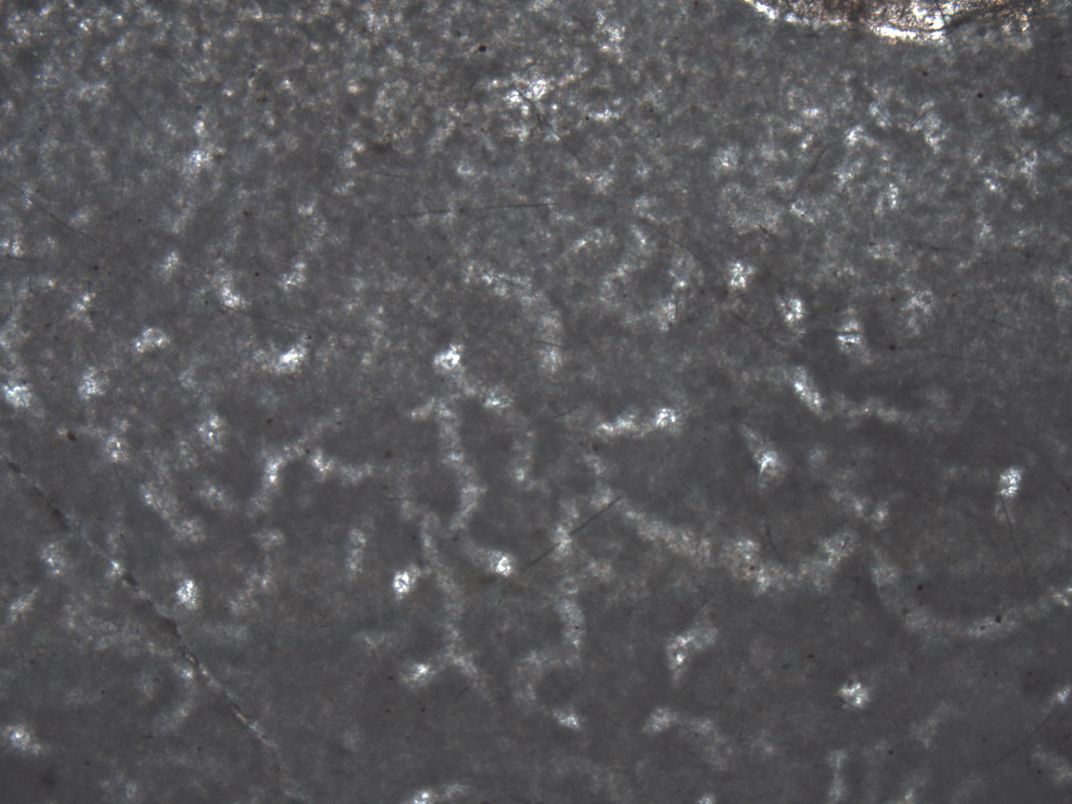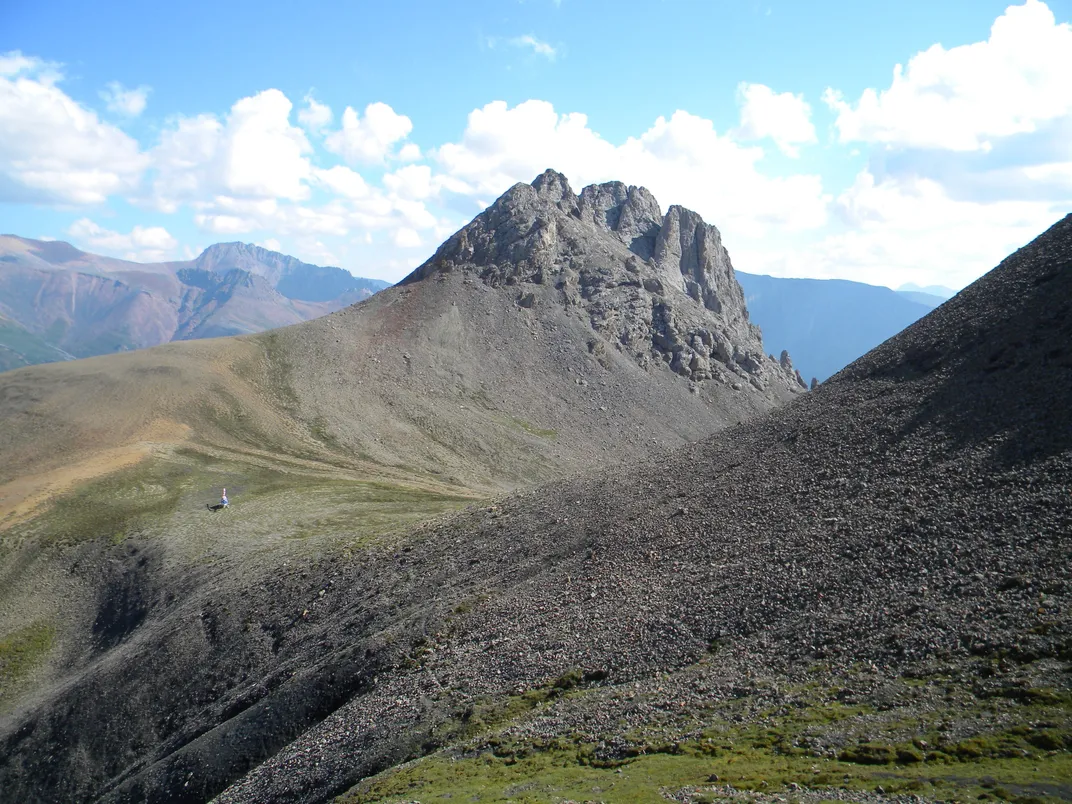This Sponge Fossil May Be the Earliest Record of Animal Life
The 890-million-year-old relic predates periods of extreme cold and the planet’s second oxygenation spike
/https://tf-cmsv2-smithsonianmag-media.s3.amazonaws.com/filer/dc/3b/dc3bacf7-d8c2-467d-9089-33b54b9faf16/gettyimages-975196036_opening.jpg)
More than two decades ago, when Elizabeth Turner was still a graduate student studying fossilized microbial reefs, she hammered out hundreds of lemon-sized rocks from weathered cliff faces in Canada’s Northwest Territories. She hauled her rocks back to the lab, sawed them into 30-micron-thick slivers—about half the diameter of human hair—and scrutinized her handiwork under a microscope. Only in about five of the translucent slices, she found a sea of slender squiggles that looked nothing like the microbes she was after.
“It just didn't fit. The microstructure was too complicated,” says Turner. “And it looked to me kind of familiar.”
Turner had an inkling of what the textured surfaces could represent. But as an early-career academic then, she withheld her findings so as not to cause a stir. After several return trips and a slew of publications by other researchers earlier this year on similar-looking fossils, Turner, now a field geologist at Laurentian University, is finally ready to step forward with her discovery: The spangled stones she found are sponge fossils dated at 890 million years old, placing sponges as the earliest prehistoric animal that humanity has ever found so far. Published today in the journal Nature, her findings suggest that animals popped up long before Earth was considered hospitable enough to support complex life.
“It's a big step forward,” says Joachim Reitner, a geobiologist at the University of Göttingen in Germany who wasn’t involved in the study. Like Turner, he’s convinced that the fossils are sponges, because the complexity of the craggy curlicues rules out all other bacterial or fungal candidates. “We have no other choices,” he says.

While they might not look the part, sponges are indeed animals—and the most basic of them all. These multicellular organisms lack the cell walls in plants and can produce sperm. Most of them live rooted in one spot all their lives in rivers or ocean bottoms. Sponges are filter feeders; their bodies contain a 3-D network of hollow channels to circulate water in and out. Simple as they are, they can sieve up to 120,000 gallons of water per pound of tissue every day to vacuum-clean out organic matter such as bacteria, which they feed on.
Turner’s fossils were once a keratosan demosponge that’s reminiscent of its modern-day descendants. This type of sponge is stiff but springy, just like the artificial cleaning sponges found in drugstores. The sponges immortalized in Turner’s rocks lived during the time when the supercontinent Rodinia—a landmass containing parts of all the modern continents—disintegrated, flooding ancestral Canada with seawater. According to Turner, her sponges probably squatted as half inch–wide patches squeezed between the nooks and crannies of reefs of photosynthesizing cyanobacteria. Earth had very little oxygen then, so Turner says that sponges likely lived where these microbial oxygen factories proliferated to allow sponges to breathe a little easier. Over the next millions of years, the sponges even survived the Cryogenian period, an era of Snowball Earth when the entire planet turned frigid and was overrun with glaciers. Another 50 to 300 million years would pass before major animals with complex biology, such as dinosaurs, would make their debut.

Not only do Turner’s fossilized sponges suggest that animals endured the oxygen-starved atmospheres and devastating Snowball Earth, they’re also nearly double the age of the next oldest evidence of sponges. But the results aren’t surprising at all, says Roger Summons, a geobiologist at MIT who wasn’t involved in the study; the sponges’ age agrees with the evolutionary timeline suggested by genomic data. The genetics of modern-day sponges puts their origins as far back as a billion years ago, says Summons, coinciding with the age of Turner’s keratosan sponge fossils.
“There's a history of life encoded into the genes of everything that's currently on the planet,” says Summons, “and the genomic data doesn’t lie.” He adds, “I'm totally comfortable with the age on the report.”
Since a microscopic maze of pale streaks is the only evidence for the earliest prehistoric sponge, a camp of skeptics disagrees with the fossils’ spongeous identity. Nick Butterfield, a paleobiologist at Cambridge University who didn’t participate in the research, says that several claims of sponges etched in similar-looking rocks have popped up in the past, only to be disproven later. He adds, should sponges have leapt onto the scene 890 million years ago, they should have rapidly transformed the planet. Instead, the age of Turner’s fossils places the sponges around the time of the Boring Billion—which scientists tout as the most stable and uneventful one-billion–year period in the planet’s history.
“Quite frankly, being an animal—even being a sponge-like animal is such a good trick. The expectation is you dramatically fill up the world with yourself,” he says. “My money is on something 100-150 million years” after the fossil’s supposed age, he adds. Then, the sponges could have sparked the Cryogenian—from 640 to 710 million years ago—by altering the geochemistry of the oceans.
Turner has an alternative explanation: sponges were sparse. They perhaps needed an additional million years or so to colonize the seafloor. “They hung around for quite a long time living in [a] particular environment, where they were happy,” she says. Perhaps ancient sponges were late bloomers, she adds, likely taking millions of years before they became the ubiquitous creatures that they are today.
Regardless of whether researchers support Turner’s findings or not, they all agree on one thing: sponges are extraordinary. Their humble physiologies belie the impact they have on the planet.
“They're all over the place, and they're totally underappreciated,” says Turner. “Who cares about Tyrannosaurus? Who cares about even fish—and definitely not mammals; but sponges are really where it's at.” She hopes that her results kickstart the discussion and spur new research on ancient sponge relics. “Understanding the weird earlier expressions of life on Earth—that's so much more fascinating than understanding the younger, more familiar ones.”
/https://tf-cmsv2-smithsonianmag-media.s3.amazonaws.com/accounts/headshot/kim.png)
/https://tf-cmsv2-smithsonianmag-media.s3.amazonaws.com/accounts/headshot/kim.png)